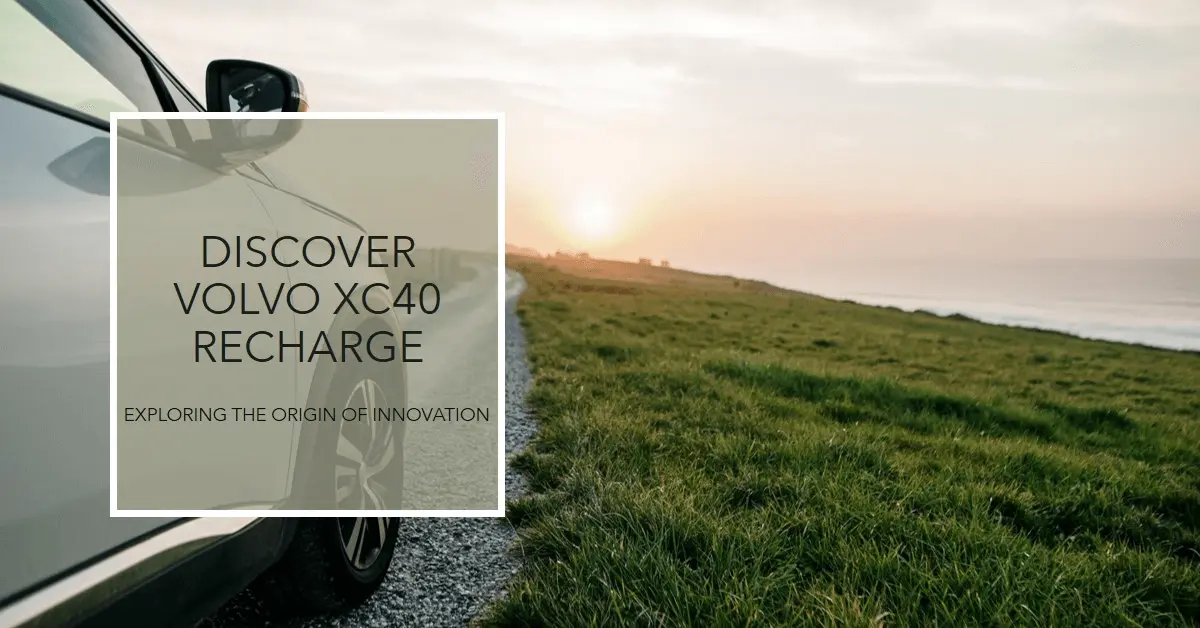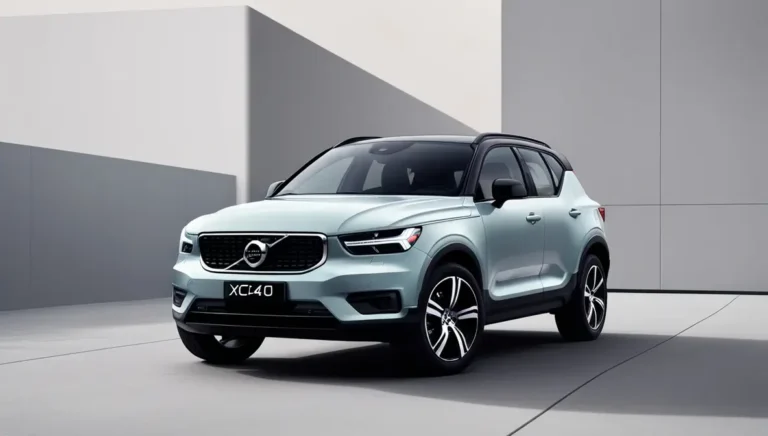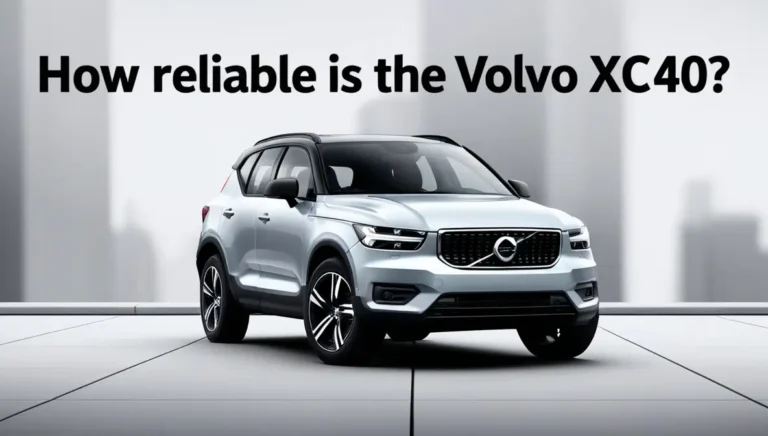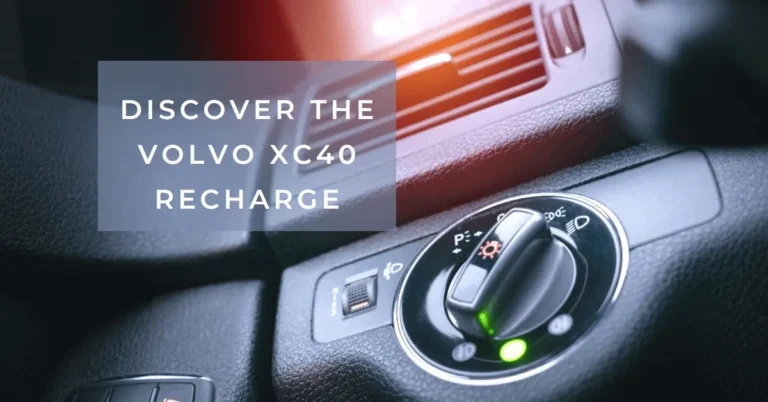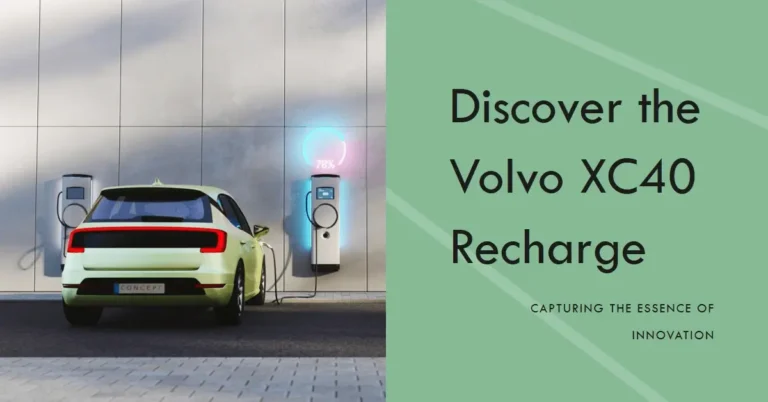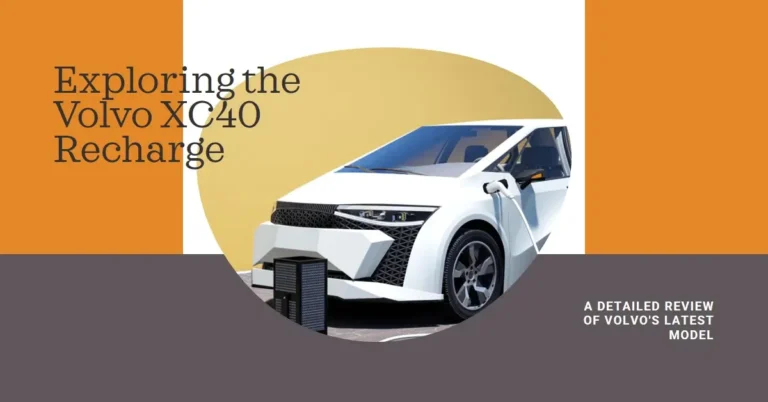Where Is Volvo XC40 Recharge Made?
You’re on the street, and suddenly, a sleek, futuristic-looking SUV catches your eye. No engine noise, just a quiet hum as it glides by. Chances are, you’ve just spotted a Volvo XC40 Recharge. But have you ever wondered where this electric beauty comes from? Well, buckle up because we’re about to take a little road trip through the world of Volvo’s electric vehicle production.
The Volvo XC40 Recharge, that stylish electric SUV turning heads on streets worldwide, is primarily manufactured in two locations: Ghent, Belgium, and Luqiao, China. But why these two spots? It’s not just a random dart throw on a map; I can tell you that much. Volvo’s got some pretty smart reasons for choosing these locations, and we will dig into all that juicy info.
Introduction to the Volvo XC40 Recharge
Let me tell you when I first laid eyes on the Volvo XC40 Recharge; it was like love at first sight – if you can fall in love with a car, that is. This isn’t just any old SUV; it’s Volvo’s bold leap into the world of all-electric vehicles. It’s got the swagger of a traditional Volvo, with that boxy-but-beautiful design, but under the hood? That’s where things get interesting.
Instead of a gas-guzzling engine, the XC40 Recharge packs a punch with its electric powertrain. Volvo took everything we love about their cars – safety, style, comfort – and said, “Hey, let’s make this thing run on electricity and save the planet while we’re at it.” And boy, did they deliver.
Now, you might wonder, “Why does it matter where this car is made?” Well, my friend, location is everything in the world of electric vehicles. It’s not just about slapping together some metal and wheels. The place where a car is born can affect everything from its carbon footprint to its price tag. Plus, with all the high-tech gizmos and specialized batteries these EVs need, you can’t just shop anywhere.
Volvo’s Global Production Facilities
The Ghent Plant in Belgium
Let’s start our tour in Ghent, Belgium. I’ve never been to Ghent, but I imagine it’s a place where medieval architecture meets cutting-edge technology. And right in the middle of all that? Volvo’s state-of-the-art manufacturing plant.
This isn’t just any factory. The Ghent plant is like the overachieving older sibling in Volvo’s family of production facilities. It’s been pumping out Volvos since 1965, and it’s got this whole “work smarter, not harder” vibe going on.
When it comes to the XC40 Recharge, Ghent is where the magic happens for Europe and many other global markets. They’ve got this production line that’s smoother than a fresh jar of Nutella. Workers and robots dance in perfect harmony, piecing together these electric marvels with a precision that would make a Swiss watchmaker jealous.
But here’s the kicker – it’s not just about making cars. The Ghent plant is like that eco-conscious friend who always reminds you to recycle. They’re all about sustainable production, which we’ll dive into later. For now, just know that when your XC40 Recharge rolls out of Ghent, a bit of Belgian finesse is baked right in.
The Luqiao Plant in China
Let’s hop on our imaginary plane and zip over to Luqiao, China. If Ghent is the overachieving older sibling, Luqiao is the ambitious younger one, eager to prove itself on the global stage.
Volvo’s operations in China aren’t just a side gig; they’re a big deal. The Luqiao plant is like this bustling hive of activity, churning out XC40 Recharge units faster than you can say “electric vehicle revolution.” It’s Volvo’s answer to the booming Chinese EV market, and let me tell you, business is booming.
This plant isn’t just about meeting local demand, though. Luqiao is flexing its muscles, producing XC40 Recharge models for regions outside Europe. It’s like Volvo’s secret weapon in their quest for global EV domination.
I remember chatting with a friend who visited the Luqiao plant. He described it as this perfect blend of Swedish engineering precision and Chinese manufacturing efficiency. Imagine robots and humans working side by side, creating these futuristic vehicles in a facility that looks straight out of a sci-fi movie.
Additional Production Sites: Future Prospects
Now, you might be thinking, “Belgium and China? That’s it?” Well, not so fast. Volvo’s got plans, my friend. Big plans.
As demand for the XC40 Recharge (and EVs in general) keeps skyrocketing, Volvo’s not just sitting back and twiddling their thumbs. They’re always on the lookout for new opportunities to expand production. They’re playing a global game of “Where’s Waldo?” but instead of finding a guy in a striped shirt, they’re scouting for the perfect spots to set up new EV factories.
And let me tell you, this isn’t just about making more cars. It’s part of Volvo’s grand master plan to go full electric faster than you can say “fossil fuels are so last century.” They’ve set this ambitious goal to become a fully electric brand by 2030. In just a few years, every new Volvo rolling off the production line will be powered by electricity.
It’s kind of exciting, isn’t it? Imagine a future where Volvo plants worldwide are humming with the production of electric vehicles. Who knows, maybe we’ll see XC40 Recharges being made in places we never expected. I’m personally rooting for a plant in Antarctica. Electric cars and penguins? Now, that’s a combo I’d love to see!
How Volvo’s Manufacturing Supports Sustainability
Green Manufacturing Practices at Volvo Plants
Okay, let’s talk green. And no, I don’t mean the colour of your neighbour’s envy when they see your shiny new XC40 Recharge. I’m talking about Volvo’s commitment to sustainable manufacturing. It’s like they’re on a mission to make Mother Nature proud.
Take the Ghent plant, for instance. These folks aren’t just making cars; they’re waging a war on carbon emissions. They’ve got this whole ecosystem of green practices that would make even the most dedicated eco-warrior nod in approval.
I once heard a story about a visitor to the Ghent plant who was so impressed by their recycling program that he went home and started a neighbourhood recycling initiative. Talk about inspiration! The plant’s got everything from energy-efficient lighting to water conservation systems. They’re trying to leave a carbon footprint so small you’d need a magnifying glass to see it.
But it’s not just about reducing waste and saving energy. The Ghent plant is playing a starring role in Volvo’s electrification strategy. They’re not just talking the talk; they’re walking the walk. Or should I say, driving the drive? Every XC40 Recharge that rolls off the line in Ghent is a step towards Volvo’s goal of becoming a fully electric brand by 2030.
Renewable Energy Use in Manufacturing
Now, let’s shine a spotlight on something that gets me excited – renewable energy. Volvo’s not just dipping their toes in the renewable energy pool; they’re doing a full cannonball splash.
The Ghent and Luqiao plants are like these giant, car-producing solar panels. Okay, not literally, but they harness a ton of solar power. It’s like they’ve got their mini suns powering the production of these electric beauties.
But it’s not just solar. They’re also big fans of wind power (pun intended). I heard that on particularly windy days, the turbines at the Ghent plant spin so fast that they could probably power a small city. Okay, I might exaggerate a bit there, but you get the idea.
And get this – they’re not just using renewable energy but constantly looking for ways to use less energy overall. It’s like they’ve got this obsession with efficiency. Every machine, every process, every light bulb is scrutinized. “Can we make this more efficient?” is probably the most asked question in Volvo plants.
I remember reading about an employee at the Luqiao plant who suggested a small change in the assembly process that saved a significant amount of energy. This kind of thinking makes Volvo’s manufacturing as green as the cars they produce.
Evolution of the Volvo XC40 Recharge: From Design to Assembly
Key Milestones in XC40 Recharge Production
Let’s take a little stroll down memory lane and look at how the XC40 Recharge went from a twinkle in a designer’s eye to the road-ready EV we know and love today.
It all started back in… well, I’d love to give you an exact date, but Volvo’s been pretty tight-lipped about the early days of the XC40 Recharge. But let’s just say it was born out of Volvo’s realization that the future is electric, and they needed to get on board or be left in the dust.
The journey from concept to production wasn’t all smooth sailing. I heard through the grapevine that there were some heated debates in the Volvo offices. Should it look like a traditional Volvo? How much range should it have? Will people buy this thing? Eventually, they ironed out the kinks and devised a design that said, “Hey, I’m a Volvo, but I’m also from the future.”
Then came the prototypes. Oh, to be a fly on the wall during those test drives! I imagine there were a lot of “Eureka!” moments mixed with a few facepalms as they fine-tuned everything from the battery placement to the user interface.
Finally, in 2019, Volvo unveiled the XC40 Recharge to the world. It was like the automotive equivalent of a mic drop. Here was a car that promised all the safety and style of a Volvo but with zero emissions. The crowd went wild (or at least, as wild as a crowd at a car unveiling can get).
Production kicked off in 2020, and let me tell you, it was like watching a snowball rolling down a hill, getting bigger and bigger. The XC40 Recharge quickly became a key player in Volvo’s lineup, pushing the brand further into the electric future.
Volvo’s Approach to Localization and Global Markets
Now, here’s where things get interesting. Volvo didn’t just create one XC40 Recharge and call it a day. Oh no, they’re smarter than that. They know that what works in Stockholm might not fly in Shanghai.
So, they came up with this clever approach to localization. It’s like they’re making a global car with a local flavour. Kind of like how McDonald’s has different menus in different countries, but way cooler because, you know, it’s cars.
The Ghent plant tailors the XC40 Recharge for the European market to meet specific regulations and preferences. Maybe they add extra insulation for those chilly Scandinavian winters or tweak the suspension for those winding mountain roads in the Alps.
Over in China, the Luqiao plant does its own thing. They might adjust the infotainment system to suit Chinese tastes better or modify the charging port to align with local standards. It’s all about making sure the XC40 Recharge feels at home, whether cruising down the Champs-Élysées or navigating the busy streets of Beijing.
But here’s the kicker – despite these local tweaks, every XC40 Recharge, no matter where it’s made, still screams “Volvo.” They’ve mastered the art of being globally consistent yet locally relevant.
When it comes to exporting, Volvo’s got it down to science. The Ghent plant supplies most of Europe and other global markets, while Luqiao takes care of China and some regions outside Europe. It’s like this carefully choreographed dance of production and distribution, all aimed at getting the right cars to the right places at the right time.
I once chatted with a Volvo dealer who told me about a customer adamant about getting a China-made XC40 Recharge in Europe because he thought it would be “more exotic.” The dealer had to explain that they’re all the same high-quality Volvo, made in different places. Goes to show that the grass isn’t always greener on the other side of the production line!
Key Differences Between the XC40 Recharge Production in Belgium and China
Market Distribution and Production Differences
Now, you might be thinking, “Hold up, if they’re making the same car in two different places, surely there must be some differences, right?” Well, my curious friend, you’d be right on the money.
While the XC40 Recharge coming out of Ghent and the one rolling off the line in Luqiao are essentially the same car, some subtle differences exist in how they’re produced and distributed. It’s like how twins might dress slightly differently to express their individuality.
In Ghent, production is all about serving the European market and beyond. They’ve got this finely tuned operation that’s been perfected over decades of making Volvos. The plant is set up to handle the specific requirements of European regulations, which can be stricter than in other parts of the world. They’re cooking up a gourmet meal to satisfy the pickiest food critics.
Over in Luqiao, things are a bit different. The plant is newer, built with the latest technology and designed specifically with EVs in mind. It’s like comparing a modern smart home to a beautifully restored Victorian house – both are great but have different strengths.
The Luqiao plant focuses primarily on meeting the enormous demand in the Chinese market, which is the world’s largest electric vehicle market. But they’re not just China-centric. They also produce for other markets outside Europe. They’re running a global kitchen, whipping up dishes for various tastes.
When it comes to customization, both plants have their own flavours. You might see more European options like wool blend upholstery (popular in eco-conscious markets) or specific driver assistance features tailored to European driving conditions.
In China, the customization might lean more towards tech features. I heard a story about a Chinese customer thrilled to discover his XC40 Recharge had a karaoke function in the infotainment system. Now, that’s what I call market-specific adaptation!
But here’s the thing – despite these differences, Volvo maintains strict quality control across both plants. Whether your XC40 Recharge comes from Belgium or China, you still get a top-notch Volvo. It’s like ordering your favourite dish at different branches of a restaurant chain – the core recipe is the same, but each chef might add a little twist.
Why Volvo Chose Belgium and China for XC40 Recharge Production
Strategic Importance of the Ghent Plant
Now, let’s talk about why Volvo picked Ghent, Belgium, as one of the birthplaces for the XC40 Recharge. And no, it wasn’t just for the waffles (although I bet that was a nice bonus for the workers).
Ghent’s got this perfect storm of factors that make it ideal for producing the XC40 Recharge. First off, it’s a smack dab in the heart of Europe. Location, location, location, right? This means they can ship cars to major European markets faster than you can say, the “electric vehicle revolution.”
But it’s not just about geography. Belgium’s got some serious political and economic stability going on. When investing millions in a production facility, you want to know it won’t be affected by political upheavals or economic rollercoasters. Belgium’s like that reliable friend who always shows up on time and never flakes on plans.
Plus, Ghent has a skilled workforce building Volvos for decades. These folks know Volvos inside and out. It’s like they’ve got Volvo DNA. I once heard about a worker there who could identify a Volvo model just by the sound of its door closing. Now that’s expertise!
And let’s not forget about the infrastructure. Ghent’s top-notch transportation links make shipping cars and receiving supplies easy. It’s like the plant sits in the middle of a giant, efficient transportation web.
I remember chatting with a logistics expert who described Ghent’s location as a “distribution dream.” He said getting an XC40 Recharge from the plant to a showroom in Paris or Berlin was smoother than a freshly paved highway.
But here’s the real kicker – the Ghent plant has been at the forefront of Volvo’s sustainability efforts. They’ve been implementing green technologies and practices for years. So when it came time to produce an all-electric vehicle, Ghent was already ahead of the game. It’s like they were preparing for the XC40 Recharge before they even knew it was coming!
Why China’s Luqiao Plant Is Critical
Now, let’s hop over to the other side of the world and discuss why Volvo chose Luqiao, China, as their second XC40 Recharge production hub. And no, it wasn’t just because they loved Chinese food (though I’m sure that didn’t hurt).
First things first – China is the world’s largest market for electric vehicles. It’s like the EV party of the century, and everyone’s invited. By producing the XC40 Recharge in Luqiao, Volvo’s essentially saying, “We’re not just attending this party; we’re helping to host it!”
The demand for EVs in China is skyrocketing faster than a SpaceX rocket. I once saw a graph of China’s EV sales, and let me tell you, that line was going up so steep it could give you vertigo. Volvo can meet this massive demand more efficiently by producing locally and adapting quickly to market trends.
But it’s not just about selling cars in China. The Luqiao plant is also a key player in Volvo’s global strategy. It’s like their secret weapon in the battle for EV supremacy. The plant’s state-of-the-art facilities and skilled workforce allow Volvo to achieve serious economies of scale.
What does that mean in plain English? Well, it’s like buying in bulk at Costco. The more XC40 Recharges they produce, the cheaper each one becomes. And those savings? They can be passed on to consumers or reinvested in developing even cooler EV tech.
I once heard a story about a Volvo exec who visited the Luqiao plant. He was so impressed by the production efficiency and quality that he jokingly asked if they could pack up the entire factory and ship it back to Sweden. Talk about a souvenir!
But jokes aside, the Luqiao plant isn’t just about quantity. It’s a hub of innovation. The Chinese automotive industry is evolving quickly, especially in the EV sector. With a strong presence there, Volvo can tap into this innovative spirit and stay at the cutting edge of electric vehicle technology.
It’s like they’ve got their finger on the pulse of the EV revolution. New battery technology? They’re on it. Advancements in electric motors? They’re all over it. It’s like being in Silicon Valley during the tech boom but for cars.
Future of Volvo’s EV Production
Expansion Plans for EV Manufacturing
Let’s put on our fortune-telling hats and peek into the crystal ball of Volvo’s future EV production. And let me tell you, the future looks electric!
Volvo isn’t just dipping its toes in the EV pool; they’re doing a full cannonball splash. They’ve got this ambitious plan to increase their EV production capacity globally. It’s like they’re playing a real-life game of Sim City, but instead of building virtual cities, they’re planning real EV factories.
I heard a rumour (and remember, it’s just a rumour, so don’t quote me on this) that Volvo’s looking at potential sites for new EV plants in North America and other parts of Asia. It’s like they’re on a global scavenger hunt, but instead of looking for hidden treasures, they’re scouting for the perfect spots to make more electric Volvos.
But it’s not just about building new plants. Volvo is also considering upgrading its existing facilities to handle more EV production. It’s like they’re giving their factories a high-tech makeover. Out with the old, in with the electric!
And get this – these expansion plans tie directly into Volvo’s sustainability goals. They’re not just aiming to make more EVs; they want to make them in the most environmentally friendly way possible. It’s like they’re trying to win a “greenest car company” competition that nobody else knows they’re in.
I once chatted with a Volvo engineer who was so excited about these plans that he could barely sit still. He described it as “the most exciting time in automotive history since the invention of the car itself.” Now that’s saying something!
How the XC40 Recharge Fits Into Volvo’s Electrification Roadmap
Now, let’s zoom in and look at how our star player, the XC40 Recharge, fits into Volvo’s grand electric scheme. Spoiler alert: it’s playing a pretty big role!
The XC40 Recharge isn’t just another car in Volvo’s lineup. It’s like the opening act in Volvo’s electric concert. It’s setting the stage for a whole symphony of EVs to come.
Volvo has this crazy ambitious goal of becoming a fully electric car brand by 2030. In less than a decade, every new Volvo rolling off the production line will be powered by electricity. They plan to go from 0 to 100 in EV terms faster than their cars can go from 0 to 60!
The XC40 Recharge is like the test pilot for this electric future. It’s helping Volvo learn valuable lessons about everything from production processes to customer preferences in the EV market. It’s like they’re using it as a real-world laboratory on wheels.
I heard a story about a Volvo product planner who said the insights they’ve gained from the XC40 Recharge have been “worth their weight in lithium” (that’s battery humour for you). These lessons are shaping the development of future Volvo EVs, from compact cars to large SUVs.
But the XC40 Recharge isn’t just a stepping stone. It’s here to stay and evolve. Volvo is constantly tweaking and improving it based on feedback and technological advancements. It’s like the XC40 Recharge is growing up right before our eyes.
And here’s a little insider tip (but keep it between us, okay?): Word on the street is that Volvo’s planning some pretty exciting updates for the XC40 Recharge in the coming years. Longer range? Faster charging? More power? Who knows! It’s like waiting for the next season of your favourite TV show – you know it will be good, but you’re not quite sure what will happen.
Conclusion: Why Production Location Matters to Consumers
So, we’ve taken this whirlwind tour of Volvo’s XC40 Recharge production, from the historic streets of Ghent to the bustling industrial zones of Luqiao. But you might wonder, “Why should I, as a consumer, care about where my car is made?”
Well, my friend, the production location of your XC40 Recharge (or any car, for that matter) is more important than you might think. Knowing where your food comes from gives you insight into the quality, sustainability, and even the story behind your vehicle.
First, the production location can affect your car’s carbon footprint. An XC40 Recharge made in Ghent and sold in Europe has travelled a shorter distance than one made in Luqiao and shipped across the ocean. It’s like the difference between buying local produce and importing exotic fruits – both can be great, but one has a smaller environmental impact on transportation.
Then there’s the matter of quality control. While Volvo maintains high standards across all its plants, each facility has strengths and specialities. It’s like how a chef might be known for a particular dish – both Ghent and Luqiao make excellent XC40 Recharges, but there might be subtle differences that appeal to different consumers.
The production location can also influence the price of your XC40 Recharge. Factors like labour costs, local regulations, and shipping expenses can all play a role. It’s like how the price of a latte can vary depending on whether you’re buying it in New York City or a small town in the Midwest.
But perhaps most importantly, knowing where your XC40 Recharge comes from connects you to its story. It’s not just a car; it’s a product of its environment, shaped by its birthplace’s culture, expertise, and innovation. Whether it’s Belgium’s centuries-old engineering tradition or China’s cutting-edge tech scene, your XC40 Recharge carries a bit of its homeland with it.
I once met a proud XC40 Recharge owner who could tell you not just the specs of his car but also fun facts about the Ghent plant where it was made. He felt like he wasn’t just driving a car but participating in a global story of automotive evolution. Now, that’s what I call an engaged consumer!
Ultimately, Volvo’s approach to producing the XC40 Recharge in Belgium and China showcases its commitment to balancing global reach with local relevance. It’s a testament to their efforts to create a truly global electric vehicle while still maintaining the quality and sustainability that the Volvo brand is known for.
So, the next time you see an XC40 Recharge silently cruising down the street, remember – it’s not just an electric car. It’s a globe-trotting ambassador of Volvo’s electric future, carrying a little piece of Belgium or China. And who knows? As Volvo expands its EV production, the next one you see might come from somewhere entirely new. The electric revolution is just starting, and Volvo’s ensuring it’s a worldwide phenomenon!

